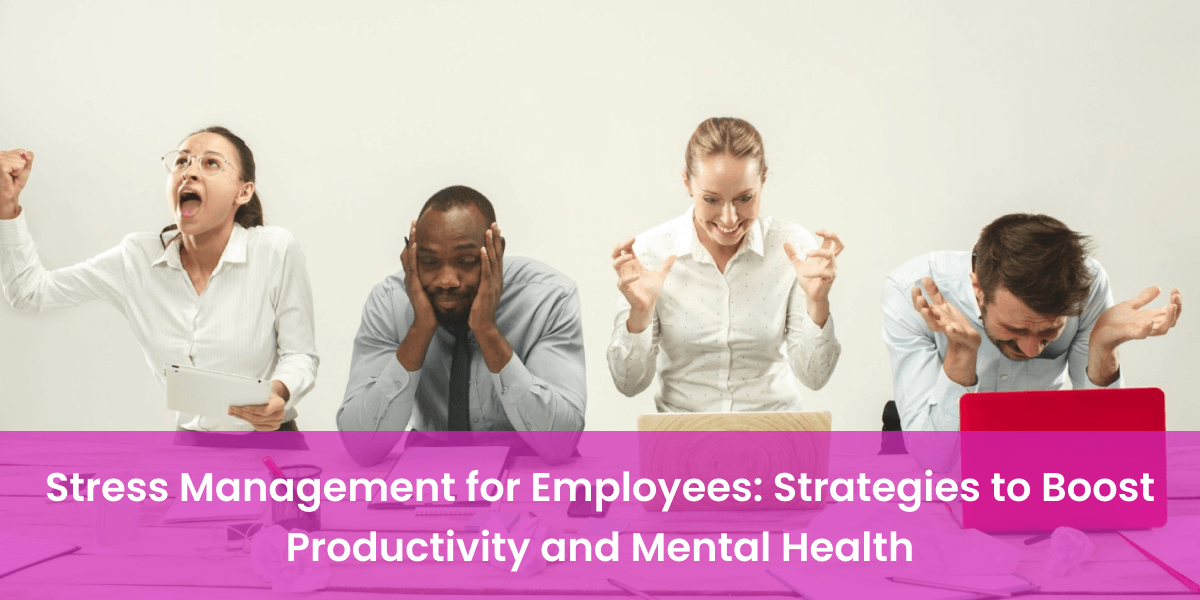In the context of contemporary working conditions, stress management is crucial not just for every single worker’s personal well-being but also for organizational success in general. In the modern days, employees are likely to face a plethora of stressor factors from their deadlines to conflicts, which would have both a direct effect on their performance as well as a dramatic impact on their mental well-being. Greater support is needed from employers to foster stress-managing cultures within their employee base.
From increased productivity to boosted morale among employees, the different ways in which stress can be managed effectively can better any workplace. Organizations can provide an enabling environment where stress is recognized and responded to at its first indication, encouraging teams to work at high performance with mental toughness. This paper speaks of practical strategies that employers can put in place to help employees manage stress effectively, boost well-being, and job performance.
What is Workplace Stress?
Workplace stress refers to the emotional, physical, and mental strain experienced by employees due to various factors in their work environment. It arises when there is a disconnect between the demands of the job and an individual’s ability to cope with those demands. Common stressors include heavy workloads, tight deadlines, lack of control over work processes, interpersonal conflicts, and job insecurity.
Understanding workplace stress is essential for employers to effectively support their employees’ well-being and productivity. It not only affects the individual’s mental health but can also lead to decreased job satisfaction, increased absenteeism, and reduced overall organizational performance. By identifying and addressing the root causes of stress in the workplace, organizations can foster a healthier and more productive work environment for their employees.
Common Causes of Workplace Stress
Workplace stress can stem from a variety of sources, each impacting employees differently. Recognizing these common causes is crucial for employers aiming to mitigate stress and improve overall workplace well-being:
- Heavy Workloads: Assigning tasks that exceed an employee’s capacity or resources.
- Tight Deadlines: Imposing unrealistic time frames for project completion.
- Lack of Job Control: Limited autonomy or decision-making authority over work processes.
- Poor Communication: Inadequate information flow, unclear expectations, or ineffective feedback mechanisms.
- Interpersonal Conflicts: Disagreements, personality clashes, or unresolved issues among colleagues.
- Job Insecurity: Concerns about layoffs, restructuring, or uncertainty about the future of their role within the organization.
Addressing these factors proactively can help create a less stressful work environment and support employees in managing their workload and mental well-being effectively.
Signs and Symptoms of Workplace Stress
Recognizing the signs and symptoms of workplace stress is essential for early intervention and support. Employees experiencing stress may exhibit a variety of physical, emotional, and behavioral indicators that signal their struggle to cope with work-related pressures.
Here are some common signs and symptoms of workplace stress:
Physical Symptoms:
- Headaches or migraines
- Fatigue or low energy levels
- Muscle tension or pain
- Digestive issues, such as stomach problems or nausea
- Insomnia or difficulty sleeping
Emotional Symptoms:
- Irritability or mood swings
- Anxiety or constant worrying
- Feeling overwhelmed or unable to relax
- Low self-esteem or feelings of inadequacy
- Depression or sadness
Behavioral Symptoms:
- Increased absenteeism or tardiness
- Withdrawal from social interactions or team activities
- Decreased productivity or performance
- Changes in appetite or eating habits
- Increased use of alcohol or drugs
Recognizing these signs can help employers and colleagues offer support and implement strategies to reduce stress levels and promote a healthier work environment.
The Impact of Stress on Productivity and Mental Health on Employees
Stress in the workplace can significantly affect both productivity and mental well-being, highlighting the need for effective stress management strategies. When employees experience prolonged or intense stress, it can lead to various negative impacts that hinder their performance and overall job satisfaction.
Here are key impacts of stress on employees’ productivity and mental health:
- Reduced Productivity: Difficulty concentrating, making decisions, or completing tasks efficiently.
- Increased Absenteeism: Higher rates of absenteeism due to physical or mental health issues related to stress.
- Burnout: Feelings of exhaustion, detachment, and a sense of ineffectiveness in their role.
- Poor Morale: Decreased motivation and job satisfaction, affecting overall morale within the team.
- Physical Health Issues: Stress-related ailments such as hypertension, cardiovascular problems, or compromised immune function.
- Mental Health Strain: Increased risk of anxiety disorders, depression, or other mental health issues.
Addressing these impacts through supportive workplace practices and stress management initiatives can improve employee well-being and contribute to a more productive and positive work environment.
Effective Stress Management Strategies for Employees
Incorporating effective stress management strategies is crucial for fostering a healthy work environment and promoting employee well-being. These strategies empower employees to cope with workplace stressors proactively, enhancing their resilience and overall productivity.
1. Promote Work-Life Balance
Achieving a balance between work and personal life is essential for reducing stress levels. Encourage employees to prioritize their well-being outside of work by setting clear boundaries between professional responsibilities and personal time. This may include flexible work arrangements, encouraging breaks, and respecting off-hours communication policies. By promoting work-life balance, employers help mitigate burnout and improve overall job satisfaction.
2. Provide Stress Management Training
Offering stress management training equips employees with the skills and techniques needed to cope with and reduce stress effectively. Training sessions can cover stress awareness, relaxation techniques, time management skills, and mindfulness practices. Providing access to resources such as workshops, webinars, or counseling services demonstrates organizational commitment to supporting employee well-being and enhancing resilience in the face of workplace challenges.
3. Encourage Regular Physical Activity
Physical activity is a powerful antidote to stress, promoting both physical health and mental well-being. Encourage employees to incorporate regular exercise into their daily routines. This can range from promoting active breaks during the workday to subsidizing gym memberships or organizing group fitness activities. Physical activity helps reduce stress hormones, improves mood through the release of endorphins, and enhances overall resilience to stressors in the workplace.
4. Foster a Supportive Work Environment
Creating a supportive work environment where open communication and collaboration are encouraged can significantly reduce stress levels among employees. Foster positive relationships among team members, promote effective communication channels, and provide opportunities for constructive feedback and recognition. A supportive environment helps employees feel valued, heard, and motivated, which in turn reduces the impact of stressors and enhances overall job satisfaction.
5. Promote Time Management and Prioritization
Effective time management and prioritization skills are essential for minimizing stress related to workload and deadlines. Encourage employees to set realistic goals, prioritize tasks, and manage their time efficiently. This can include techniques such as creating daily to-do lists, breaking tasks into manageable steps, and using time-tracking tools or productivity apps. By empowering employees with organizational skills, employers help alleviate stress associated with feeling overwhelmed by workload demands.
6. Offer Mental Health Resources
Provide access to mental health resources and support services to help employees manage stress and maintain mental well-being. This may include Employee Assistance Programs (EAPs), counseling services, or partnerships with mental health professionals. Ensure confidentiality and promote stigma-free access to these resources so that employees feel comfortable seeking help when needed. By prioritizing mental health support, employers demonstrate commitment to employee wellness and create a culture where mental health is valued and supported.
Implementing these stress management strategies demonstrates organizational commitment to employee well-being and contributes to a positive work environment where individuals can thrive professionally and personally.
Organizational Role in Stress Management
Organizations play a pivotal role in mitigating workplace stress and promoting a supportive environment conducive to employee well-being. By actively addressing stressors and implementing effective strategies, employers can enhance productivity, job satisfaction, and overall organizational success.
Factors in Organizational Role in Stress Management:
1. Leadership and Communication:
Effective leadership fosters open communication, sets clear expectations, and provides supportive guidance. Leaders should prioritize transparent communication channels, encourage feedback, and be empathetic to employees’ concerns. By promoting a culture of trust and support, leaders can help alleviate stress and boost morale within the organization.
2. Workload Management:
Proactively manage workloads to prevent overload and burnout. This includes realistic goal-setting, proper delegation of tasks, and assessing staffing needs to ensure workload distribution is equitable. Providing employees with the resources and support necessary to accomplish tasks efficiently helps reduce stress associated with overwhelming work demands.
3. Promotion of Work-Life Balance:
Encourage work-life balance by offering flexible work arrangements, promoting vacation time usage, and respecting boundaries between work and personal life. Organizations can implement policies that support employees in managing their time effectively and prioritizing self-care, which contributes to reduced stress levels and improved overall well-being.
4. Training and Development:
Invest in training programs that equip employees with stress management skills, resilience-building techniques, and strategies for maintaining mental health. Offer workshops, seminars, or access to resources that enhance emotional intelligence, mindfulness, and coping mechanisms. By providing ongoing learning opportunities, organizations empower employees to navigate stressors effectively and enhance their professional growth.
5. Health and Wellness Initiatives:
Implement wellness programs that focus on physical health, mental well-being, and stress reduction. This can include wellness challenges, access to fitness facilities or classes, nutritional counseling, and initiatives promoting mindfulness or relaxation techniques. By prioritizing employee health, organizations create a supportive environment that reduces stress and fosters a culture of well-being.
6. Supportive Policies and Resources:
Establish policies that prioritize mental health support, such as Employee Assistance Programs (EAPs), counseling services, or access to confidential resources for managing stress and personal challenges. Ensure policies are accessible, communicated effectively, and stigma-free to encourage employees to seek assistance when needed. Providing comprehensive support demonstrates organizational commitment to employee welfare and contributes to a positive workplace culture.
By actively engaging in these factors, organizations not only mitigate workplace stress but also cultivate a positive and resilient workforce. Prioritizing employee well-being as a strategic imperative leads to enhanced productivity, increased job satisfaction, and sustainable organizational success in the long term.
Related Blog: Stress Management for Teachers: Practical Tips to Maintain Balance and Resilience
FAQs about Stress Management for Employees
Here are answers to some common questions about managing stress in the workplace:
Q1. How does stress affect productivity?
Stress can significantly impact productivity by impairing concentration, decision-making abilities, and overall cognitive function. When employees are stressed, they may struggle to focus on tasks, leading to errors, missed deadlines, and decreased efficiency. Moreover, stress can contribute to absenteeism and presenteeism, where employees are physically present but not fully engaged or productive. Addressing stress through supportive environments and effective management strategies is crucial for maintaining high levels of productivity and performance.
Q2. What are some effective time management techniques for reducing stress?
Effective time management can help reduce stress by providing structure and clarity in handling workload and responsibilities. Techniques such as prioritizing tasks based on urgency and importance, breaking tasks into smaller, manageable steps, and using tools like calendars or task lists can enhance productivity and reduce feelings of being overwhelmed. Setting realistic goals and deadlines, along with scheduling regular breaks to recharge, also contributes to better stress management and improved overall well-being.
Q3. Why is managing stress important for mental health?
Managing stress is essential for mental health because chronic or excessive stress can lead to anxiety disorders, depression, and other mental health issues. Stress triggers the release of hormones like cortisol, which, when prolonged, can negatively impact brain function and emotional regulation. By implementing stress management techniques such as mindfulness, physical activity, and seeking social support, individuals can mitigate the harmful effects of stress on mental health, promoting resilience and emotional well-being.
Q4. What role does diet play in stress management?
Diet plays a significant role in stress management as certain foods and nutrients can impact mood and stress levels. Consuming a balanced diet rich in fruits, vegetables, whole grains, lean proteins, and healthy fats supports overall well-being and helps regulate stress hormones. Avoiding excessive caffeine, sugar, and processed foods can prevent energy crashes and mood swings associated with stress. Adequate hydration is also crucial for cognitive function and managing stress effectively.
Q5. How important is sleep in managing stress?
Quality sleep is essential for managing stress because it allows the body and mind to rest, recover, and recharge. Sleep deprivation can exacerbate stress levels by impairing cognitive function, emotional regulation, and overall resilience to stressors. Establishing a regular sleep schedule, creating a relaxing bedtime routine, and minimizing disruptions in the sleep environment contribute to better sleep quality. Prioritizing sufficient sleep duration supports optimal mental and physical health, enhancing the ability to cope with workplace stress effectively.
Conclusion
Effective stress management is not just a beneficial practice but a necessity in today’s dynamic workplaces. By prioritizing strategies that support employee well-being, organizations can foster a culture where individuals thrive both professionally and personally. Addressing workplace stress through proactive measures such as promoting work-life balance, providing resources for stress management, and creating supportive environments not only enhances productivity but also cultivates a positive organizational climate.
Investing in stress management is an investment in the health, satisfaction, and longevity of employees. As organizations recognize the significant impact of stress on both individual performance and overall organizational success, integrating these strategies becomes integral to sustaining a resilient and productive workforce. By empowering employees with the tools and support needed to manage stress effectively, organizations can create environments where everyone can contribute their best while maintaining optimal mental and emotional well-being.









Post a Comment